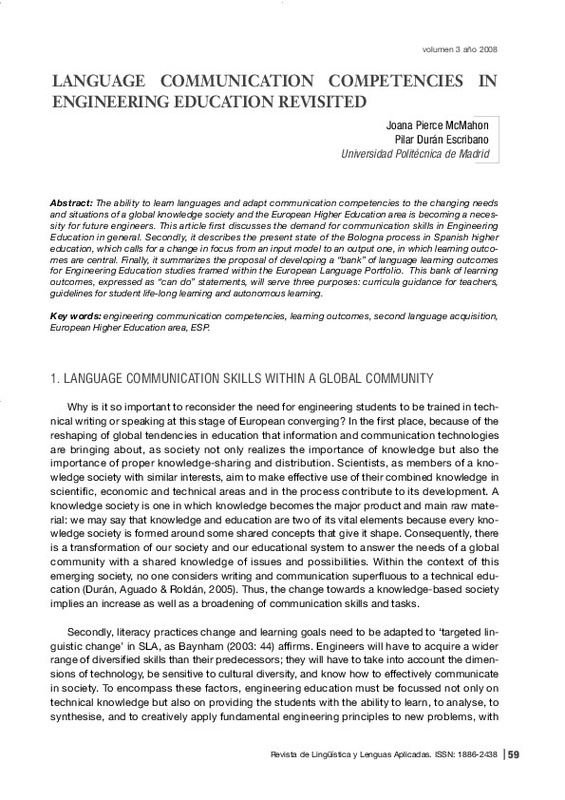Alha, K. (2004). "Portfolio assessment on chemical reactor analysis and process design courses." European Journal of Engineering Education, 29-2: 267-273.
Barton, D.; M. Hamilton, & R. Ivanic (eds.) (2000). Situated Literacies: reading and writing in context. London: Routledge.
Bary, R. & M., Rees (2006). "Is (self-directed) learning the keys kill for tomorrow's engineers?" European Journal of Engineering Education, 31-1: 73-81.
[+]
Alha, K. (2004). "Portfolio assessment on chemical reactor analysis and process design courses." European Journal of Engineering Education, 29-2: 267-273.
Barton, D.; M. Hamilton, & R. Ivanic (eds.) (2000). Situated Literacies: reading and writing in context. London: Routledge.
Bary, R. & M., Rees (2006). "Is (self-directed) learning the keys kill for tomorrow's engineers?" European Journal of Engineering Education, 31-1: 73-81.
Baynham, M. (2003). "Taking the social turn: the new literacy studies in SLA" in G. Luque; A. Bueno & G. Tejada (eds.). Languages in a Global World. Jaén: Universidad de Jaén Servicio de Publicaciones: 43-68.
Bhatia, V. (2004). Worlds of Written Discourse. A genre-based view. London: Continuum.
Council of Europe, (2001). Common European Framework of Reference for Languages: Learning, teaching, assessment. Strasbourg: Cambridge University Press.
Council of Europe, (2004). ECTS Users Guide. (Brussels). Available on lineat: www.bologna.msmt.cz/files/ECTSUsersGuide.pdf [retrieved: 7.6.2006].
Durán, P.; L. Aguado, A.M. Roldán (2005). "Introduction to reflections on language use" in Durán, P.; L. Aguado, A.M. Roldán (eds.) Reflections on Language Use in the Academic Context. Madrid: Fundación Conde Valle Salazar, UPM, 1-16.
Durán, P. & J. Pierce (2007). "A Literacy Portfolio for University Students: Academic and Professional Discourse Development with in the European Framework of Reference for Languages" in Curado, A., Edwards, P. & Rico, M. (eds.) Approaches to Specialised Discourse in Higher Education and Professional Contexts. Newcastle, UK: Cambridge Scholars Publishing: 182-197.
Durán, P. & J. Pierce (2006). "Specific features of a Language Portfolio for EST students: Pilot Study" in Pérez-LLantada C. et al (eds) Academic and Professional Communication in the 21st Century: Genres and Rhetoric in the Construction of Disciplinary Knowledge. Zaragoza: Universidad de Zaragoza: 403-410.
Gonzalez, J. & R. Wagenaar (2003). Tuning Educational Structures in Europe. Final Report. Phase One. Bilbao: University of Deusto & University of Groningen. Available online at: http://www.tuning.unideusto.org/tuningeu [retrieved:22.8.2006].
Foster Vosicki, B. (2002). European Language Portfolio for Higher Education. Bern: European Language Council.
Huba, M.E. & J.E. Freed (2000). Learner-Centered Assessment on College Campuses: Shifting the Focus from Teaching to Learning. Bilbao: Allyn and Bacon.
Huckin, T.N. & L. Olsen (1991). Technical and Professional Communication for Nonnative Speakers of English. Boston: McGraw-Hill.
Johns, A.M. (2002). Genre in the Classroom. Multiple Perspectives. New Jersey: Lawrence Earlbaum Associates.
Lenz, P. and G. Schneider (2004). A bank of descriptors for self-assessment in European Language Portfolios. Strasbourg: Council of Europe. Available on line at www.coe.int/portfo-lio. [retrieved: 2.10.2006].
Light, G. & R. Cox (2001). Learning and Teaching in Higher Education: The Reflective Professional. London: Paul Chapman.
Littlemore, J. (2004). "Item-based and cognitive-style-based variation in student's ability to use metaphoric extension strategies. IBÉRICA (Revista de AELFE), 7:5-32.
Littlemore, J. & G. Low (2006). Figurative Thinking and Foreign Language Learning. New York: Palgrave Macmillan. https://doi.org/10.1057/9780230627567
Pierce, J. & P. Úbeda (2006). "The European Language Portfolio: Review of the Implementation in Higher Education" en Aprendizaje de lenguas, uso del Lenguaje y modelación cognitiva, XXIV Congreso Internacional AESLA. Madrid: UNED: 990-997.
Scottish Government. http://www.scotland.gov.uk/Publications/2004/09/19908/42706.[retrieved:6.6.2007].
[-]








